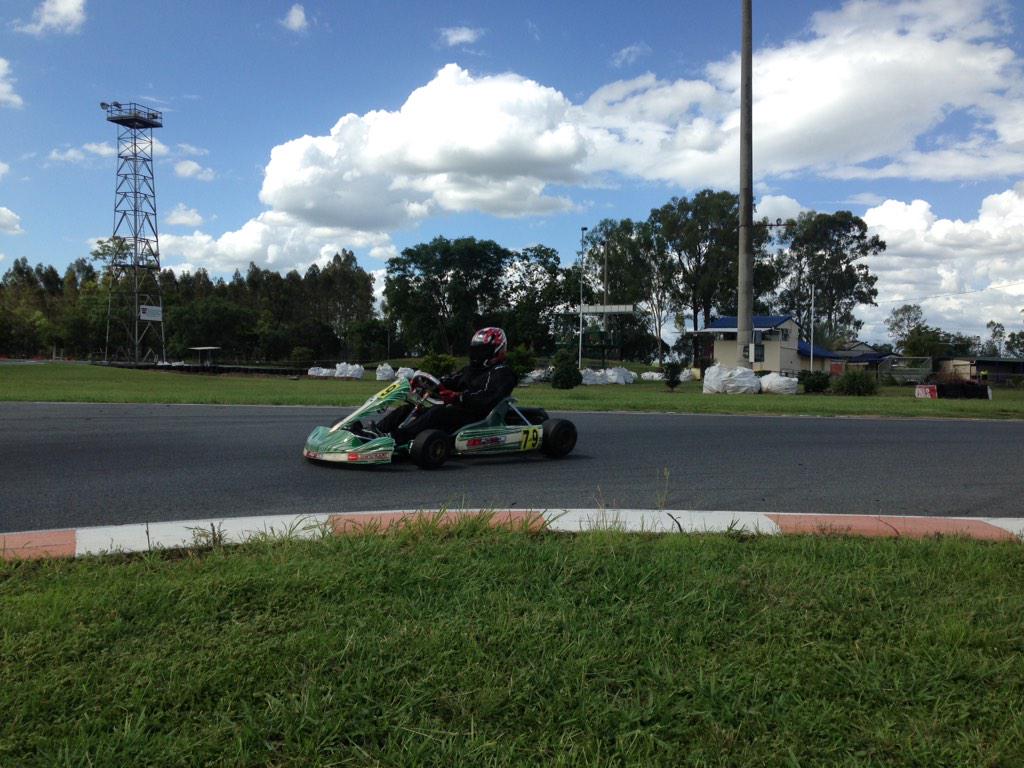
A lifting or lowering of a car or kart chassis in relationship to the ground is called jacking. On a kart, this lifting of the tire is called a jacking effect, as if you had taken a jack and lifted the kart. In reality, although you can feel some wobble in the kart, the tires normally don’t move up and down enough to really be able to seesaw but this should illustrate the concept. One front tire and the diagonally opposite tire are the pivot points and the two other tires can bounce up and down. To picture this, you might pretend the kart is now a seesaw. Only three tires can be resting evenly on the ground at any one time now. Since the four tires are no longer even, they cannot all rest on the ground evenly. This happens in a car as well, but the effect is much more pronounced in a kart.

The front outside tire will go up and the front inside tire will go down. When we turn a kart, the front-end steering geometry causes the front tires to go up or down in relation to the chassis. In a kart, turning the steering wheel is significantly more important than just for controlling the direction you are going. We'll come back to this later on, but first let's look at ways we can go about creating this three-wheeled kart. It has no "wobble" because it essentially has 100% rear load transfer and the rear outside tire's load and therefore grip potential becomes basically static. Our three-legged barstool kart however, is balanced on only three tires during a corner. This is done through varying front and rear roll resistance and therefore load transfer. In simplistic terms, you can use a car's ability to “wobble” to alter the balance of the car. Cars are the four-legged barstools, and karts are the three. This is the difference between cars and karts. It is never wobbly unlike a four legged bar stool that needs legs of perfectly equal length in order to not wobble. Think of a bar stool that only has three legs. Most adjustments on a kart are only about ways to get that rear inside tire unloaded the proper amount. There are some nuances to this, but most of the adjustments you can make have absolutely no effect on a properly cornering kart. Once that rear tire unloads, which it should be throughout most of the turn, basically the only thing that affects the balance of the kart is the location of the center of gravity in relation to the three loaded tires. We'll look at how this works shortly, but first there is something important to cover that many people might not realize about how a kart works. In fact, usually you want the bare minimum unloading needed to allow the kart to turn. Although it sometimes occurs, actually lifting the tire into the air is not necessary, only removing enough load from the inside tire so that it's not creating excess force in the wrong direction. So how do we go about turning our seemingly four-wheeled kart into a three-wheeled vehicle? You must lift that inside rear wheel, or more specifically, you must unload the tire through the use of steering geometry and chassis flex. The solution instead is to make the kart use only the outer rear tire while cornering. The rear tires on a kart are so much larger than the fronts because only one is being used at a time to balance out the grip from the front tires.Ī kart's solid axle causes both rear wheels to rotate at the same speed. But fitting a differential to a kart would be expensive, it’s against the rules, and it would totally change everything about karting. This makes turning very difficult. Cars deal with this situation with a differential, which allows the rear wheels to spin at different speeds. If both rear tires are planted on the ground and you try to turn, the inner tire will spin across the ground too fast and it will push the inside of the kart in a straight line. But what about the back wheels? They are stuck together by the solid rear axle and must spin at exactly the same rate.

#G FORCE KARTS FAQ FREE#
On a kart, this is easily done by the front wheels because they are independent and free spinning. The tighter the turn, the bigger the difference in the wheel speeds. Because of this, the inner tires travel less distance, and therefore they need to spin slower than the outer tires. The outer ones go through a larger arc than the inner ones. When both cars and karts negotiate a turn, the outer and inner wheels go through different arcs.


 0 kommentar(er)
0 kommentar(er)
